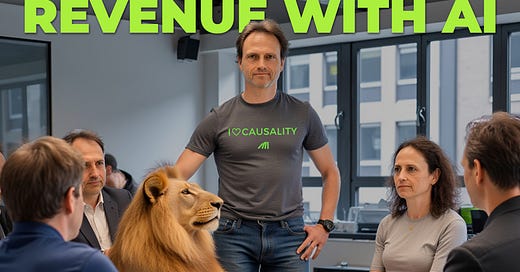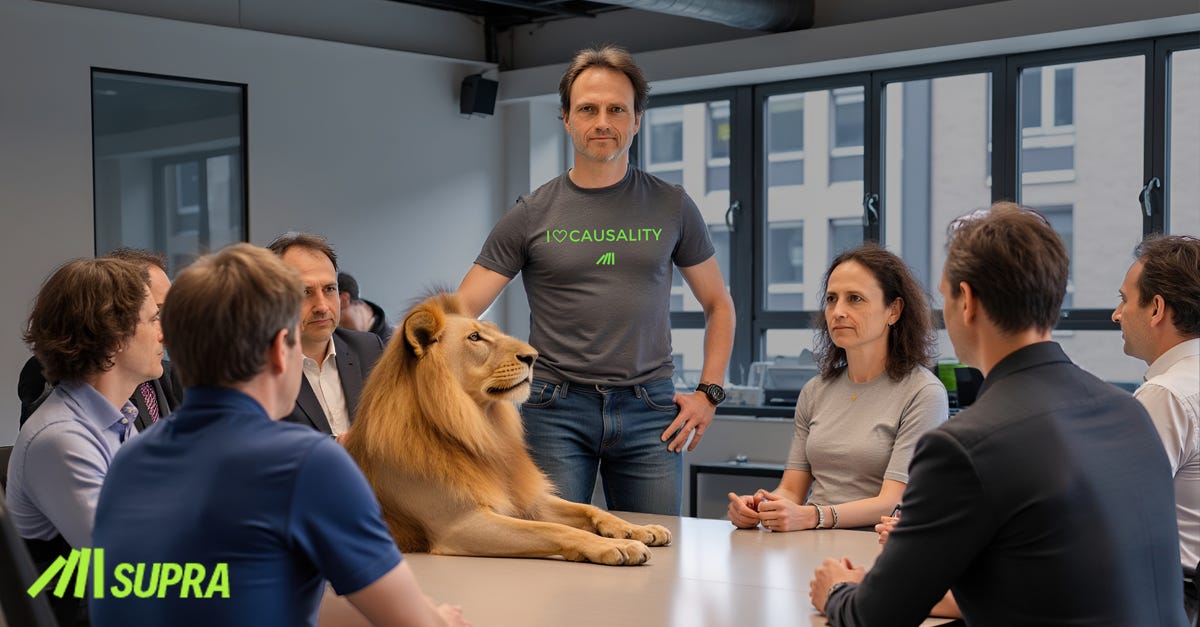Listen to the audio version here!
In a recent discussion, Microsoft CEO Satya Nadella compared today’s AI boom to the dot-com bubble, with many AI applications failing to deliver real value. Let’s explore the limitations of traditional AI in marketing and uncover how AI can drive measurable business growth.
The AI Confusion at the C-Level
AI hype is deafening, leaving decision-makers more perplexed than ever. They ask:
Is AI more than just content and video generation?
What real business problems can AI solve?
How can AI enhance marketing strategy, execution, pricing, forecasting, and sales optimization?
What resources and investment are required?
How can I start small and see a quick return on investment?
These are the critical questions I want to address—right now.
What Do We Mean by AI?
To navigate the AI landscape, we must distinguish between three fundamentally different types of AI:
1. Generative AI:
This includes tools like ChatGPT, Midjourney, and Suno. It dominates 95% of the AI buzz. Its core function is predicting the next word (for LLMs) or generating new content by training on vast datasets.
2. Predictive AI:
These domain-specific systems forecast specific outcomes. For example, eye-tracking models predict where people will look in an image. Predictive AI leverages specialized datasets to accomplish highly specific tasks.
3. Causal AI:
Unlike Predictive AI, which tells you what might happen, Causal AI identifies why things happen. It uncovers the drivers behind success or failure and provides actionable insights to influence outcomes.
AI Wave #1 – AI in Marketing Today
Causal AI isn’t new, but it remains underutilized. Meanwhile, Generative and Predictive AI are already in widespread use:
Predictive AI Applications:
Automating ad testing
Categorizing car accident photos in customer service
Churn scoring, recommender systems, and other predictive models
Generative AI Applications:
Creating visuals, copy, and music
Assisting with desk research
Powering customer service chatbots
Looking at these examples, AI today is primarily used to reduce costs and improve efficiency. But revenue growth happens when you create value, not just cut costs.
Exception: When Henry Ford cut car production costs by a factor of three, he didn’t just save money—he unlocked new demand at an affordable price. If AI doesn’t cut costs in that magnitude and create value by this in your industry, it’s not yet a game-changer.
How Can AI Drive Revenue Growth?
True marketing impact isn’t about doing things faster or cheaper—it’s about doing them better.
AI should help you:
Develop stronger brand positioning and marketing strategies
Design better products that fulfill customer needs
Craft more compelling communication to enhance brand awareness and lead generation
Improve distribution and promotions to boost availability
Optimize sales tools for better conversions, upselling, and cross-selling
Enhance customer experiences to increase loyalty and reduce churn
Refine analytics to create a continuous improvement loop for marketing spend
However, while Predictive and Generative AI help optimize execution, they don’t answer the most critical question: “How do we create better marketing?”
AI Wave #2 – Driving Growth with Causal AI
Every marketer, insights professional, and data scientist engages in causal analysis—trying to determine why certain strategies work (or fail). However, most methods today are flawed, relying on confirmation bias rather than true exploration.
Causal AI changes the game by applying self-learning techniques that uncover unknown relationships between marketing tactics and business outcomes.
How Causal AI Has Driven Growth for Brands:
T-Mobile USA: Used Causal AI to dissect and refine its 2013 strategy, leading to 4x revenue growth and a turnaround from losses to profitability.
Apple Vision Pro: Neuro-market research with Causal AI revealed that while intuitive control was a major selling point, customers didn’t trust it would work. Addressing this insight was key to launch success.
Samsung: Digital ads initially created with Generative AI saw a breakthrough in performance when Causal AI identified the Brand Archetypes that resonated most with audiences.
Läderach: The luxury chocolate brand used Causal AI to pinpoint local store-level tactics that boosted foot traffic and sales.
Nonprofits: A Causal AI-optimized direct mail strategy increased donor conversion rates by 40%.
Sonos: Analyzing NPS feedback with Causal AI revealed that reliable streaming (not just sound quality) was the key to customer satisfaction—leading to a 10-point NPS increase in six months.
Just Eat: Causal AI-enhanced touchpoint models uncovered that driver appearance directly negatively impacted brand perception, prompting crucial operational improvements.
“Growth Requires Better Marketing…
Which Requires Better Insights…
Which Requires Causal AI.”
AI Wave #3 – The Need for AI “Lion Tamers”
AI technology—whether Generative, Predictive, or Causal—must be used as an orchestra. The challenge is selecting the right tools based on methodological soundness and impact, not just ease of use or popularity.
However, as AI advances, organizations risk lowering their analytical standards. Instead of adapting to AI, brands must transform their organizations to leverage AI effectively.
Historical Context:
The steam engine reduced physical labor on farms, shifting jobs to factories.
Robotic automation reduced factory work, shifting jobs to services.
Digitalization automated services, shifting jobs to strategy and human interaction.
Now, AI is automating even high-level white-collar work.
We no longer need employees with textbook knowledge—AI knows that 100x better. Instead, we need experts who can critically assess AI’s output and enhance its effectiveness by asking better questions.
The AI Lion Tamer: The Missing Role in Organizations
AI automates standard know-how work and basic human intelligence. But if companies leave AI in the hands of employees with only surface-level expertise, they risk veering off course.
It’s not enough to be 10x better with AI if your competitors are using it to get 100x better.
This challenge has already emerged in digital transformation. In marketing, DIY insights tools allow teams to bypass research departments and agencies, reducing costs but also leading to poor decision-making. The problem? Non-experts are now choosing the AI tools they rely on—often prioritizing ease of use over real impact.
AI is advancing rapidly, and organizations need experts who can critically assess its outputs. Ethan Mollick’s “Expert Paradox” research shows that true experts don’t just accept AI’s answers—they challenge and refine them, leading to significantly better results.
Brands need AI Lion Tamers—individuals who deeply understand both AI and marketing science. These experts will be scarce, and many companies will need external guidance to stay competitive.
Unlocking Growth with AI-Powered, Actionable Insights
Right now, AI is mostly used to cut costs. But real value creation requires doing marketing better. That starts with better insights.
Causal AI—combined with Agentic AI—makes high-quality insights faster, actionable, and accessible without needing a PhD in data science.
Three Strategies to AI-Powered Growth:
Better marketing requires better insights, powered by Causal AI.
The DIY model is broken—brands need AI Lion Tamers.
Use technology AND expert oversight to pilot causal insights in weeks and impact in months.
This is how you 10x profitable growth.







Thank you so much for this clear and insightful sharing, which brings light into a field where I get bombarded with superficial messages yelled at me with almost religious enthusiasm or apocalyptic fear.